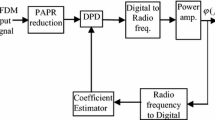Abstract
In this paper, we propose an active point modification (APM) scheme to suppress the sidelobe of orthogonal frequency division multiplexing (OFDM) signals, and the key idea of APM is slightly enlarging the amplitudes of constellation points on some sub-carriers while keeping unchanged the minimum distance between constellation points. Moreover, the peak-to-average power ratio of the OFDM signal is considered. We formulate the sidelobe suppression problem by APM as a quadratically constrained quadratic programming problem, which could be solved by numerical tools. Simulation results show that APM could provide well sidelobe suppression performance while the peak-to-average power ratio could be efficiently controlled at a desired level.












Similar content being viewed by others
References
Mitola, J. (1999). Cognitive radio for flexible mobile multimedia communications. In Proceedings of MoMuC, November 1999, CA, USA.
Stotas, S., & Nallanathan, A. (2011). Enhancing the capacity of spectrum sharing cognitive radio networks. IEEE Transactions on Vehicular Technology, 60(8), 3768–3779.
Quan, Z., Cui, S., Sayed, A., & Poor, H. V. (2009). Optimal multiband joint detection for spectrum sensing in dynamic spectrum access networks. IEEE Transactions on Signal Processing, 57(3), 1128–1140.
Weiss, T., Hillenbrand, J., Krohn, A., & Jondral, F. (2004) Mutual interference in OFDM-based spectrum pooling systems. In Proceedings of VTC, May 2004, CA, USA.
Yamaguchi, H. (2004) Active interference cancellation technique for MB-OFDM cognitive radio. In Proceedings of EuMW (Vol. 2), October 2004, Amsterdam, The Netherlands.
Wang, Z., Qu, D., & Jiang, T. (2008). Spectral sculpting for OFDM based opportunistic spectrum access by extended active interference cancellation. In Proceedings of Globecom, November 2008, New Orleans, USA.
Qu, D., Wang, Z., & Jiang, T. (2010). Extended active interference cancellation for sidelobe suppression in cognitive radio OFDM systems with cyclic prefix. IEEE Transactions on Vehicular Technology, 59(4), 1689–1695.
Brandes, S., Cosovic, I., & Schnell, M. (2006). Reduction of out-of-band radiation in OFDM systems by insertion of cancellation carriers. IEEE Communications Letters, 10(6), 420–422.
Mahmoud, H. A., & Arslan, H. (2008). Sidelobe suppression in OFDM-based spectrum sharing systems using adaptive symbol transition. IEEE Communications Letters, 12(2), 133–135.
Li, D., Dai, X., & Zhang, H. (2009). Sidelobe suppression in NC-OFDM systems using constellation adjustment. IEEE Communications Letters, 13(5), 327–329.
Cosovic, I., Brandes, S., & Schnell, M. (2005). A technique for sidelobe suppression in OFDM systems. In Proceedings of Globecom, November 2005, St. Louis, MO.
Cosovic, I., Brandes, S., & Schnell, M. (2006). Subcarrier weighting: A method for sidelobe suppression in OFDM systems. IEEE Communications Letters, 10(6), 444–446.
Cosovic, I., & Mazzoni, T. (2007). Sidelobe suppression in OFDM spectrum sharing systems via additive singal method. In Proceedings of VTC, April 2007 (pp. 2692–2696).
Pagadarai, S., Rajbanshi, R., Wyglinski, A. M., & Minden, G. J. (2008). Sidelobe suppression for OFDM-based cognitive radios using constellation expansion. In Proceedings of WCNC, March 2008, Las Vegas, NV, USA.
Chung, C. D. (2008). Spectral precoding for rectangularly pulsed OFDM. IEEE Transactions on Communications, 56(9), 1498–1510.
Han, S., Cioffi, J., & Lee, J. (2008). On the use of hexagonal constellation for peak-to-average power ratio reduction of an OFDM signal. IEEE Transactions on Wireless Communications, 7(3), 781–786.
Tellado, J. (1999). Peak to average power reduction for multicarrier modulation, Chap. 3. Ph.D. dissertation, Stanford University.
Boyd, S., & Vandenberghe, L. (2004). Convex optimization, Chap. 4, and Chap. 11. Cambridge: Cambridge University Press.
Grant, M., & Boyd, S. (2010). Cvx usersguide for cvx version 1.21 (build 782), May 2010. [Online]. Available: http://cvxr.com/.
Author information
Authors and Affiliations
Corresponding author
Rights and permissions
About this article
Cite this article
Zhou, Y., Jiang, T. Active point modification for sidelobe suppression with PAPR constraint in OFDM systems. Wireless Netw 19, 1653–1663 (2013). https://doi.org/10.1007/s11276-013-0561-5
Published:
Issue Date:
DOI: https://doi.org/10.1007/s11276-013-0561-5




